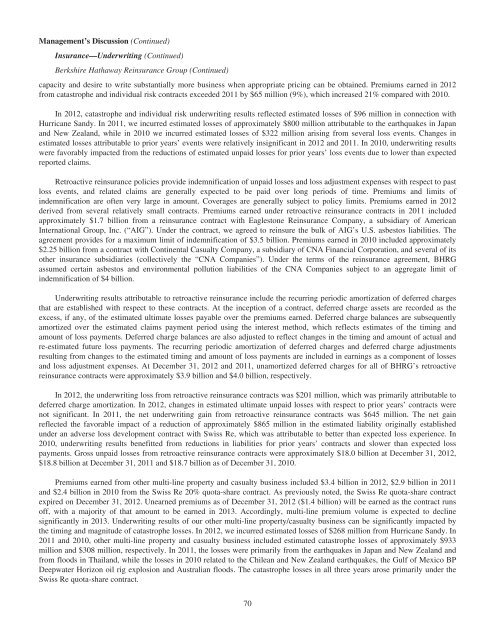BERKSHIRE HATHAWAY
BERKSHIRE HATHAWAY
BERKSHIRE HATHAWAY
Create successful ePaper yourself
Turn your PDF publications into a flip-book with our unique Google optimized e-Paper software.
Management’s Discussion (Continued)<br />
Insurance—Underwriting (Continued)<br />
Berkshire Hathaway Reinsurance Group (Continued)<br />
capacity and desire to write substantially more business when appropriate pricing can be obtained. Premiums earned in 2012<br />
from catastrophe and individual risk contracts exceeded 2011 by $65 million (9%), which increased 21% compared with 2010.<br />
In 2012, catastrophe and individual risk underwriting results reflected estimated losses of $96 million in connection with<br />
Hurricane Sandy. In 2011, we incurred estimated losses of approximately $800 million attributable to the earthquakes in Japan<br />
and New Zealand, while in 2010 we incurred estimated losses of $322 million arising from several loss events. Changes in<br />
estimated losses attributable to prior years’ events were relatively insignificant in 2012 and 2011. In 2010, underwriting results<br />
were favorably impacted from the reductions of estimated unpaid losses for prior years’ loss events due to lower than expected<br />
reported claims.<br />
Retroactive reinsurance policies provide indemnification of unpaid losses and loss adjustment expenses with respect to past<br />
loss events, and related claims are generally expected to be paid over long periods of time. Premiums and limits of<br />
indemnification are often very large in amount. Coverages are generally subject to policy limits. Premiums earned in 2012<br />
derived from several relatively small contracts. Premiums earned under retroactive reinsurance contracts in 2011 included<br />
approximately $1.7 billion from a reinsurance contract with Eaglestone Reinsurance Company, a subsidiary of American<br />
International Group, Inc. (“AIG”). Under the contract, we agreed to reinsure the bulk of AIG’s U.S. asbestos liabilities. The<br />
agreement provides for a maximum limit of indemnification of $3.5 billion. Premiums earned in 2010 included approximately<br />
$2.25 billion from a contract with Continental Casualty Company, a subsidiary of CNA Financial Corporation, and several of its<br />
other insurance subsidiaries (collectively the “CNA Companies”). Under the terms of the reinsurance agreement, BHRG<br />
assumed certain asbestos and environmental pollution liabilities of the CNA Companies subject to an aggregate limit of<br />
indemnification of $4 billion.<br />
Underwriting results attributable to retroactive reinsurance include the recurring periodic amortization of deferred charges<br />
that are established with respect to these contracts. At the inception of a contract, deferred charge assets are recorded as the<br />
excess, if any, of the estimated ultimate losses payable over the premiums earned. Deferred charge balances are subsequently<br />
amortized over the estimated claims payment period using the interest method, which reflects estimates of the timing and<br />
amount of loss payments. Deferred charge balances are also adjusted to reflect changes in the timing and amount of actual and<br />
re-estimated future loss payments. The recurring periodic amortization of deferred charges and deferred charge adjustments<br />
resulting from changes to the estimated timing and amount of loss payments are included in earnings as a component of losses<br />
and loss adjustment expenses. At December 31, 2012 and 2011, unamortized deferred charges for all of BHRG’s retroactive<br />
reinsurance contracts were approximately $3.9 billion and $4.0 billion, respectively.<br />
In 2012, the underwriting loss from retroactive reinsurance contracts was $201 million, which was primarily attributable to<br />
deferred charge amortization. In 2012, changes in estimated ultimate unpaid losses with respect to prior years’ contracts were<br />
not significant. In 2011, the net underwriting gain from retroactive reinsurance contracts was $645 million. The net gain<br />
reflected the favorable impact of a reduction of approximately $865 million in the estimated liability originally established<br />
under an adverse loss development contract with Swiss Re, which was attributable to better than expected loss experience. In<br />
2010, underwriting results benefitted from reductions in liabilities for prior years’ contracts and slower than expected loss<br />
payments. Gross unpaid losses from retroactive reinsurance contracts were approximately $18.0 billion at December 31, 2012,<br />
$18.8 billion at December 31, 2011 and $18.7 billion as of December 31, 2010.<br />
Premiums earned from other multi-line property and casualty business included $3.4 billion in 2012, $2.9 billion in 2011<br />
and $2.4 billion in 2010 from the Swiss Re 20% quota-share contract. As previously noted, the Swiss Re quota-share contract<br />
expired on December 31, 2012. Unearned premiums as of December 31, 2012 ($1.4 billion) will be earned as the contract runs<br />
off, with a majority of that amount to be earned in 2013. Accordingly, multi-line premium volume is expected to decline<br />
significantly in 2013. Underwriting results of our other multi-line property/casualty business can be significantly impacted by<br />
the timing and magnitude of catastrophe losses. In 2012, we incurred estimated losses of $268 million from Hurricane Sandy. In<br />
2011 and 2010, other multi-line property and casualty business included estimated catastrophe losses of approximately $933<br />
million and $308 million, respectively. In 2011, the losses were primarily from the earthquakes in Japan and New Zealand and<br />
from floods in Thailand, while the losses in 2010 related to the Chilean and New Zealand earthquakes, the Gulf of Mexico BP<br />
Deepwater Horizon oil rig explosion and Australian floods. The catastrophe losses in all three years arose primarily under the<br />
Swiss Re quota-share contract.<br />
70


